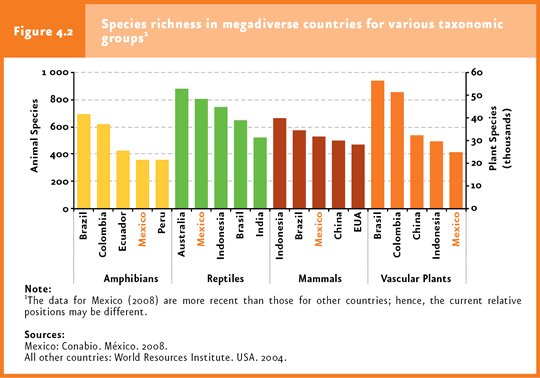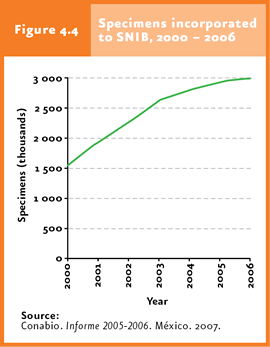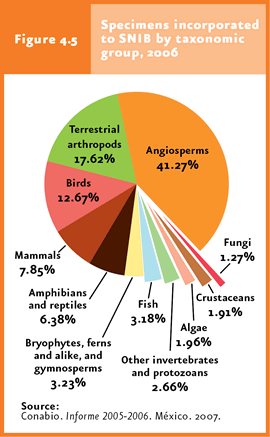
Mexico includes between 10 and 12% of the world species, ranking second in reptile species richness, third in mammals, fourth in amphibians and fifth in vascular plants. |
Mexico stands out because of the number of endemism it includes: nearly 77% of cacti species, 32% of mammal species and 11% of bird species are endemic. |
Approximately 15% of total plant species consumed worldwide originated in Mexico. |
It has been calculated that the economic value of services provided by biodiversity and ecosystems may range between 16 and 54 billion USD, that is, nearly twice the world’s annual gross product. |
| CHAPTER 4. BIODIVERSITY |
Virtually all vegetation types existing worldwide can be found in Mexico, as well as a large number of species of the most important taxonomic groups. However, as in the rest of the world, biodiversity currently faces an important crisis, which has resulted from the disruptions caused by human activities on ecosystems to meet the growing demand for food, clothing, households, energy and water of a population that grew disproportionally from the past century. All this has brought about, in addition to the loss and deterioration of the multiple environmental services provided by ecosystems, extinction rates that in some cases are even higher than those observed in fossil records. Threats into biodiversity include changes in land use, infrastructure construction, demographic growth, introduction of invasive species, forest fires, overexploitation of natural resources, illegal resource use and the global climate change. In view of this situation, a series of strategies have been implemented both in Mexico and worldwide aimed at reducing and controlling the threats to biodiversity, offsetting their effects and reverting the ecosystems´ deterioration.
MEXICO, A MEGADIVERSE COUNTRY Mexico is one of the most diverse countries worldwide from the biological standpoint. Its geographic location and complex geological history, among the main factors, had led to a varied arrangement of conditions that have enabled the coexistence of biological elements of multiple origins (e. g. tropical and boreal), as well as an intense diversification of the taxonomic groups within its territory. In this way, Mexico possesses an especially significant richness at the three biodiversity levels (ecosystems, species and genes). Up to date, between 1.7 and 2 million species have been described over the world, although estimates suggest that this number may well range between 10 and 30 million species (CBD, 2002; CONABIO, 2006). From that total, it is estimated that some 10 to 12% are located in the Mexican territory (despite that Mexico accounts for just 1.5% of the total Earth surface), a reason for which Mexico is regarded as a megadiverse country, along with Brazil, Peru, Colombia, Indonesia and China, among others. The country's fauna includes some 125,585 species of invertebrates, mostly insects (which represent nearly 48,000 species). As for vertebrates, about 5,500 species have been recorded, mostly fish (2,695 species) and birds (1,107 species, Figure 4.1). Even when the number of species belonging to other vertebrate groups is lower, Mexico ranks second in terms of reptile richness worldwide (804 species) and third in mammal species (535 species, Figure 4.2).
As regards the national flora, nearly 24,800 species of vascular plants have been described, mostly angiosperms (a little over 22,250 species), representing approximately 9% of all the species currently described worldwide (about 270,000 species). Mexico is included among the five countries with the highest number of vascular plants species (Figure 4.2).
The species richness of any given country is also supplemented with endemisms, that is, those species found only within its territory. To this respect, Mexico also stands out in terms of the high number of endemic species and genera. It is calculated that between 40 and 60% of vascular plant species known in the country are endemic (CONABIO, 2006; Cuadro D3_BIODIV02_01). Five hundred eighteen of the 669 cacti species reported in the country (i.e. nearly 77%), 169 of the 535 mammal species (32%), and 125 out of 1107 birds species (11%) are endemic (Figure 4.3). If endemism are analyzed according to the vegetation type, it is found that some 60 to 70% of species present in xerophilous shrublands and temperate forests, respectively, are endemic of these ecosystems, while only 5% of the species present in tropical forest, respectively, are endemic, while only 5% of the species living in evergreen rainforests are endemic (Rzedowski, 1998).
In spite that biological richness and number of endemism in Mexico are acknowledged worldwide, species inventories have not been completed yet. This is due to the fact that there are still several biological groups that have not been totally collected and studied (e. g. fungi, terrestrial and aquatic invertebrates and other microscopic microorganisms), as well as geographic areas and ecosystems in which the investigation of wildlife has been limited (e. g. coral reefs and deep oceanic communities). Figures for many taxonomic groups will surely increase as more in-depth investigations on the country’s diversity and geography are carried out. The National Commission for the Knowledge and Use of Biodiversity (CONABIO in Spanish), has been created to foster the National Information System on Mexico´s Biodiversity (SNIB in Spanish). This system integrates the taxonomical, ecological, geographical and bibliographical information of species living in the country. SNIB comprises several specific elements and products, including databases of species deposited in national and foreign collections, catalogs from taxonomic authorities, a number of species cards listed in NOM-059-Semarnat-2001, in the CITES Appendixes, invasive and economically important species and the Information System on Modified Living Organisms (SIOVM in Spanish). In the year 2006, SNIB included about 3 million curatorial records of Mexican specimens (not including replicates, Figure 4.4), a little over 820 thousand of which came from foreign collections. Most of these records correspond to angiosperms (41.27%), terrestrial arthropods (17.62%) and birds (12.67%; Figure 4.5).
As regards ecosystem diversity, the terrestrial portion of the country includes nearly all the vegetation types described worldwide, ranging from tropical, temperate and mountain cloud forests, up to xerophilous shrublands, natural grasslands and halophile and gypsophile vegetation. This huge diversity rivals only the one of China, India, Peru and Colombia at a world level (CONABIO, 2006). Indeed, it is considered that some vegetation types, such as gypsophile grasslands present in the central highlands and “izotales” dominated by plants of the genera Dasylirion, Yucca or Nolina, are endemic to our country (González Medrano, 2003). For further details on Mexico’s plant cover, please refer to the Terrestrial Ecosystems chapter. Biological richness in aquatic environments, including both marine and freshwater bodies, is also relevant in Mexico. The country’s marine zone hosts both open- and deep-sea ecosystems (including cold-water reef areas), including grassland communities and coral reef ecosystems growing in warm waters. In terrestrial areas, aquatic ecosystems are also diverse in rivers, lakes and lagoons. For further information on diversity and its status in aquatic ecosystems, please refer to the Water chapter. In addition to species and ecosystem richness, the importance of Mexico as source of cultivated plants it is also worth noting (Cuadro D3_BIODIV05_01). It has been estimated that at least 118 plant species of economic importance were domesticated in the country, making of Mexico one of the world’s main plant domestication centers. As for the number of domesticated species, the following plant groups are worth mentioning: Cactaceae (16 species of 4 genera), Fabaceae (14 species of 9 genera) Asteraceae (9 species of 5 genera) and Agavaceae (7 species of 2 genera; CONABIO, 1998). It is estimated that a little over 15% of plant species consumed worldwide originated in Mexico, a country where about 40 varieties of corn and 120 varieties of hot pepper are grown. In the case of bean, 63 species are recorded worldwide, 52 of which are grown in Mexico and only five are cultivated by man (CONABIO, 2006). As for animals, 12 domesticated strains are recorded for Mexico, as follows: two of horses, three of pigs, four of sheep, two of bovine and one of caprine (Cuadro D3_BIODIV05_02). At the world level, knowledge on the genetic variability of wildlife species is still scarce. In Mexico, the number of species investigated is low, mostly if the enormous diversity existing in the country is taken into account (plus the fact that most studies focused on local aspects in most cases). However, investigations on genetic diversity have increased considerably in recent times, although additional synthetic work is required to gain a better understanding on the genetic diversity of Mexican wildlife species.
Biodiversity environmental services Many of the goods that mankind has enjoyed from the origins of civilization to date come from biodiversity. Plants and animals used as food and sources of fibers and leather, as well as wood and the active ingredients of many drug products are just a few examples of the goods extracted from species that once were part of natural ecosystems. These must be added to other services, little acknowledged, that species provide when these are clustered in ecosystems and interact with the surrounding environment: water uptake and purification, air quality and soil fertility maintenance, local climate regulation, littoral and coastline protection against extreme meteorological events, among others. The above examples comprise some of the so-called environmental services (refer to Box Ecosystems’ environmental services and human welfare in the Population chapter). The importance and value of environmental services associated to biodiversity have been acknowledged just recently. Despite difficulties involved in calculations, it is currently known that the economic value associated to services derived from diversity and ecosystems worldwide may range between some 16 and 54 trillion USD (Constanza et al., 1997), that is, about twice the world’s annual gross product. In the case of global fishing catch, its global value may rise to some 58 thousand million USD per year, while the global value associated to coral reefs, including cultural and supply services for tourism and fisheries, reaches 30 thousand million USD (MEA, 2005). In the case of Mexico, for instance, it has been found that fish and crab fisheries on the Gulf of California are directly related to local mangrove abundance; the economic value of this fisheries is estimated at 37 thousand 500 hundred USD per mangrove hectare (Aburto-Oropeza. et al., 2008). When this figure is considered along with the fact that environmental goods and services are, ultimately, the result of the interaction biodiversity and it surrounding environment, the crucial relevance of diversity in modern life is evident.
|




